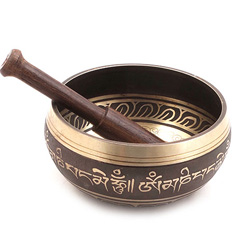Singing Bowl Guide

Oh my goodness, this is such a vast topic and there is certainly plenty of reading material to be found if you want to dive deeply into the history of these mysterious instruments, how they are made, the materials they are made from, their uses and their roles in people’s lives. In the interest of simplicity, and by way of keeping this more personal, I will write about my own journey with singing bowls and invite you to discover more through your own experiences.
Singing bowls history
The origin of singing bowls is steeped in mystery and they were no doubt being crafted long before written records existed. I have heard of people who commune at spirit level with the original artisans of old, old bowls and have provided information about these makers from over 5,000 years ago. Make of this what you will, but it is certainly the case that bells, bowls and gongs have been used for spiritual and healing work for many centuries and that these practices continue today. It is also said that the weight of the metal used to make these bowls was once used as currency and offered as gifts, meaning that many bowls could be very heavy and potentially impractical to play.
There are many sizes and types of singing bowl in the world today, from ancient hand-beaten Tibetan bowls to the newer crystal bowls that have appeared within the last ten years or so. Many of today’s instruments are now made and moulded by machine, and it’s certainly true that singing bowls available on the market will vary greatly in terms of price, quality of sound and ease of playing.
To be honest, I personally find some of the machined, modern bowls much easier to play than the hand-beaten ones. Perhaps the uniform shape facilitates the resonances more readily and consistently. However, this does not necessarily mean that the sound is of “better” quality and I would always suggest taking the time to “get to know” a bowl before making a purchase – at least allowing yourself to really “feel” its sound in person.
What does a singing bowl sound like?
I can’t say I remember when I heard a singing bowl for the first time, it just feels like they have always been in my life, but I do remember my first gong and how the vibrational field had such an immense impact on my physical and mental body that I felt like every cell was being rearranged. I also know that the sounds produced by singing bowls, gongs and tingsa bells have an instantly calming effect on me and invite me to focus on my senses and drop into a more relaxed state. The sweet chime of a singing bowl being struck like a bell, or the growing tones and harmonics as the singing sound is drawn out from the rim, speak deeply to the human psyche and these instruments are used across the world in meditation and healing practices. Paying attention to the sound and allowing the vibrations to penetrate the body is said to bring about a sense of deep relaxation, act as an aid to meditation and to assist in releasing tension and trauma.
It may be of interest that I have had the privilege to craft my own singing bowl, a small gong and four tingsa bells over the past few years. These instruments are made of brass and, as you can probably imagine, my relationship with each of them is deeply personal from the initial choosing of the metal sheet, via each and every hammer stroke, to the final polishing and sounding. The metals and techniques used throughout history are manyfold and varied, often with accompanying rituals of chanting and prayers. If a bowl is referred to as “hand-beaten” it means that the bowl has been hammered from a flat sheet of metal by hand and will be unique in the way it looks and sounds.
How are singing bowls used
To play a singing bowl one can either strike it with a wooden mallet or draw the sound out from the rim, much like inviting a wine glass to sing, by slowly moving the mallet around the outside rim of the bowl. By holding the bowl on a flat open palm, and not gripping the bowl in any way, one can often feel the vibration even before it is heard. The speed and pressure of the mallet movement can be adjusted to increase or decrease the volume and, in skilled hands, to draw out more of the rich tones and harmonics.
It is important to remember and honour the spiritual origins of all these instruments, to focus one’s attention when sounding them and to respect the role they can play in bringing about healing and harmony in our lives.
